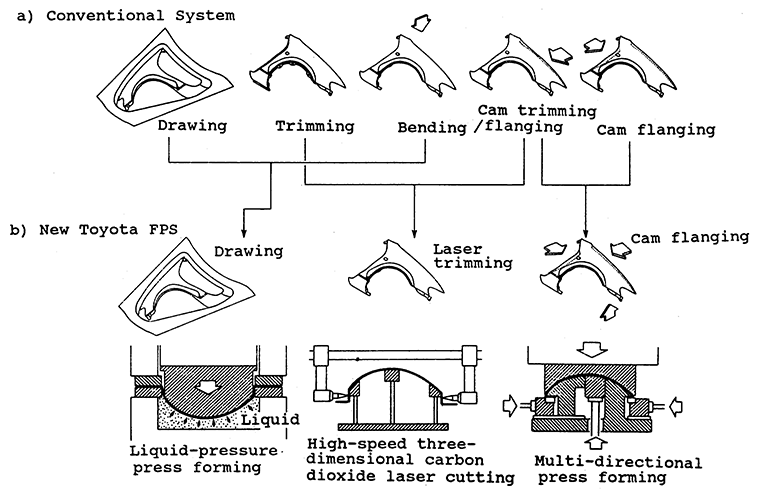Mar. 26, 1990
TOYOTA DEVELOPS NEW FLEXIBLE PRESS SYSTEM
Toyota City―TOYOTA MOTOR CORPORATION announced today that it recently developed and introduced a new flexible press system for use in small-lot manufacturing at the company. The Toyota Flexible Press System (FPS), as it is known internally, will allow Toyota to better respond to a growing trend toward "individuality" in customer tastes. The system is currently being used for the company's new gull-wing specialty car, the Sera.
The Toyota FPS consists of three major processes: "drawing," performed by a newly developed liquid-pressure press-forming method; "trimming," with a high-speed three-dimensional carbon dioxide laser cutter; and "cam flanging," by a multi-directional press forming method in which pressure is applied simultaneously from six directions. The result is enhanced product accuracy, as well as a dramatic reduction in the number of production processes.
With the new Sera's front fender, for example, Toyota was able to reduce what normally would have required five forming processes―drawing, trimming, bending, cam trimming/flanging, and cam flanging―to just three.
While yielding better quality and accuracy than conventional methods, the new Toyota FPS offers extreme flexibility and a revolutionary simplification of the press manufacturing process.
System Components
- Liquid-Pressure Press Forming Method
Employing a solid, metal die at the top and a liquid―water―at the bottom, this forming method utilizes Pascal's law, which states that a confined liquid transmits any externally applied pressure uniformly in all directions. Compared with conventional methods using metal both for upper and lower dies, the liquid-pressure method accurately yields quality products with 50% deeper drawing and less surface deflection. In addition, it contributes to a shortening of manufacturing lead time by reducing the time needed for manufacture of metal dies.To date, the method had been used only for parts with comparatively simple shapes, such as automobile headlamp reflectors and home appliances. Toyota is the first manufacturer to apply the technology to large and complex car body parts such as outer hoods, front fenders, and quarter panels.
- High-Speed, Three-Dimensional Carbon Dioxide Laser Cutter
The world's only machine to use two torches, the carbon dioxide laser cutter provides high-speed and high-accuracy trimming. The cutting position is freely adjustable by online computerized control; its versatility has eliminated the need for conventional trimming dies. Laser cutting power is double that of the conventional machine, so the two-torch setup has quadrupled the trimming capability: 1.5 minutes per fender in contrast to six minutes with the conventional method.
- Multi-Press Forming Method
Employing a multi-directional pressurizing unit covering a total of six directions (two each vertically, longitudinally, and laterally), this method has enabled a number of forming processes, such as flanging and cam flanging, to be carried out simultaneously. By integrating the numerous flanging processes needed in the conventional approach, it has simplified operations, enhanced product accuracy, and reduced the number of press dies required for production.
Press Manufacturing System

- Note
- Each arrow shows the direction of forming.
The first process is drawing, which corresponds both to drawing and bending in the conventional system, and is conducted by liquid-pressure press forming.
The second is laser trimming, corresponding both to trimming and the first half of cam trimming/flanging in the conventional system, and is performed by high-speed three-dimensional carbon dioxide laser cutting.
The third is cam flanging, which corresponds both to the second half of cam trimming/flanging and cam flanging, and is carried out by multi-directional press forming.




